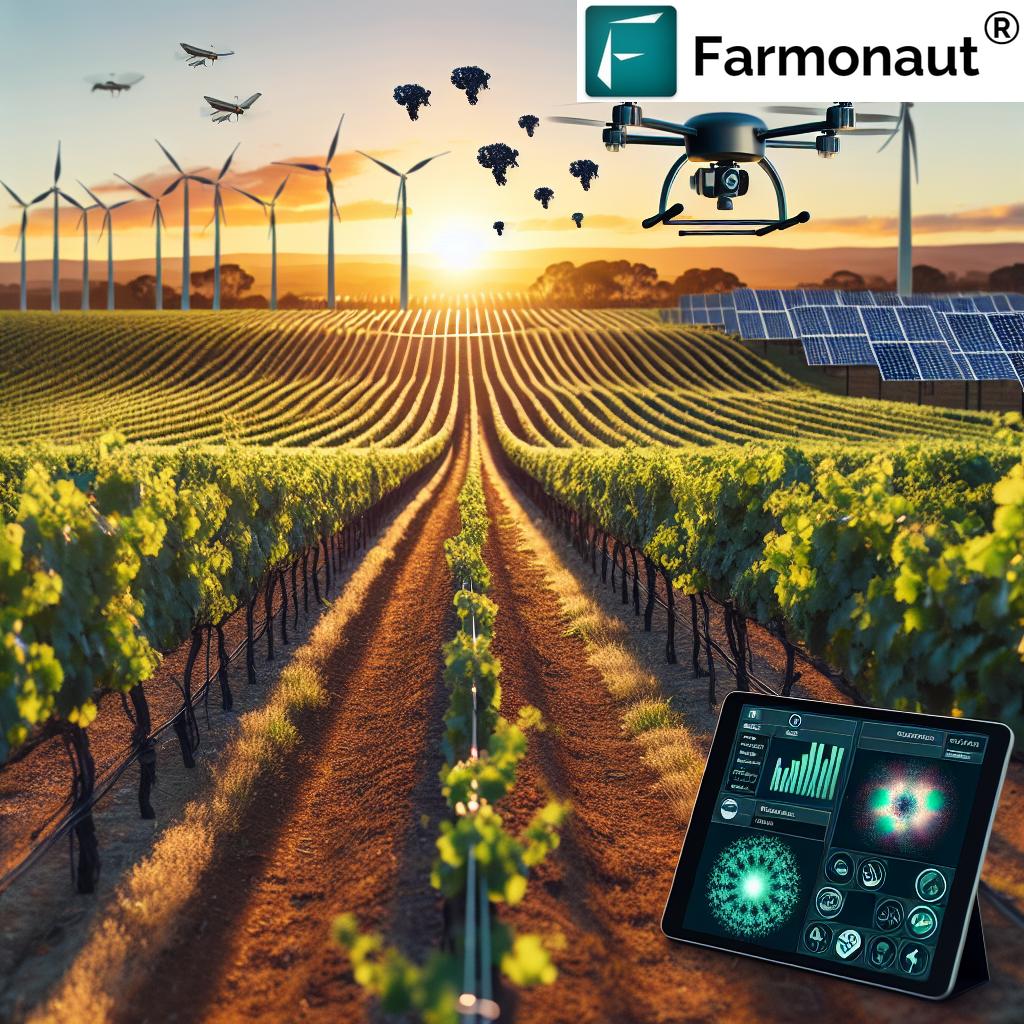Revolutionizing Australian Vineyards: GIS-Powered Sustainable Winegrowing Practices for Global Export Success

“Australian vineyards using GIS for sustainable practices have seen up to 30% increase in water efficiency.”
Welcome to our comprehensive guide on revolutionizing Australian vineyards through GIS-powered sustainable winegrowing practices for global export success. In this article, we’ll explore how innovative technologies and sustainable methods are transforming the Australian wine industry, enhancing its competitiveness in the global market.
The Australian Wine Industry: A Global Powerhouse
The Australian wine industry has long been recognized as a global leader in quality and innovation. With its diverse climate regions and commitment to sustainable practices, Australia has positioned itself as a powerhouse in the international wine market. Let’s dive into how GIS technology and sustainable winegrowing practices are shaping the future of Australian viticulture.
GIS in Vineyard Planning: A Game-Changer for Sustainable Winegrowing
Geographical Information Systems (GIS) have revolutionized vineyard planning and management in Australia. By leveraging spatial data and advanced analytics, winemakers can now make more informed decisions about:
- Site selection for new vineyards
- Optimal grapevine varieties and rootstocks for specific terroirs
- Efficient irrigation systems design
- Targeted pest and disease management strategies
One of the leading platforms in this space is Farmonaut, which offers cutting-edge satellite-based farm management solutions. Their technology integrates seamlessly with vineyard operations, providing real-time insights that drive sustainable practices.
Sustainable Winegrowing Practices: The Australian Approach
Australian vineyards are at the forefront of adopting sustainable winegrowing practices. These methods not only benefit the environment but also enhance the quality and marketability of Australian wines globally. Some key sustainable practices include:
- Water conservation through precision irrigation
- Integrated pest management to reduce chemical use
- Cover cropping for soil health improvement
- Renewable energy adoption in winery operations
By implementing these practices, Australian winegrowers are not only reducing their environmental impact but also producing wines that appeal to environmentally conscious consumers worldwide.
Innovative Vineyard Management Techniques
To stay competitive in the global market, Australian vineyards are constantly innovating their management techniques. Some cutting-edge approaches include:
- Drone technology for aerial vineyard mapping and monitoring
- AI-powered predictive analytics for yield forecasting
- Robotic pruning and harvesting systems
- Smart sensors for real-time soil and vine health monitoring
These innovations are helping Australian winemakers optimize their operations, reduce costs, and improve wine quality consistently.
Climate Change Adaptation in Australian Vineyards
Climate change poses significant challenges to the wine industry globally, and Australia is no exception. However, Australian vineyards are proactively adapting to these changes through:
- Research into heat-tolerant grape varieties
- Adjusting harvest times based on climate data
- Implementing shade cloth and misting systems
- Exploring cooler climate regions for new vineyard establishments
These adaptation strategies ensure that Australian wines maintain their quality and character despite changing climatic conditions.
The Role of Agtech in Wine Production
Agricultural technology, or agtech, is playing an increasingly important role in Australian wine production. From the vineyard to the winery, innovative technologies are enhancing efficiency and quality. Key areas of agtech application include:
- Precision viticulture using GPS and satellite imagery
- Automated sorting systems for grape selection
- Fermentation monitoring with IoT sensors
- Blockchain for supply chain traceability
Platforms like Farmonaut are at the forefront of this technological revolution, offering comprehensive solutions for vineyard management and monitoring.

Grapevine Varieties and Rootstocks: Adapting to Australian Terroir
The selection of appropriate grapevine varieties and rootstocks is crucial for producing high-quality wines that reflect Australia’s unique terroir. Australian viticulturists are constantly researching and experimenting with:
- Traditional varieties like Shiraz and Chardonnay
- Emerging varieties such as Tempranillo and Vermentino
- Rootstocks that are resistant to pests and drought
- Clonal selection for improved wine characteristics
This focus on varietal adaptation ensures that Australian wines remain distinctive and competitive in the global market.
Pest and Disease Management in Australian Vineyards
Effective pest and disease management is essential for maintaining vineyard health and wine quality. Australian vineyards are adopting integrated approaches that include:
- Biological control methods using natural predators
- Pheromone traps for pest monitoring
- Disease-resistant rootstocks and varieties
- Precision application of treatments using GIS and drones
These strategies help reduce chemical inputs while maintaining vine health and fruit quality.
Wine Export Markets: Opportunities and Challenges
Australian wines have a strong presence in international markets, but the landscape is constantly evolving. Key aspects of the export market include:
- Emerging opportunities in Asian markets, particularly China
- Maintaining traditional markets in Europe and North America
- Navigating trade agreements and tariffs
- Adapting to changing consumer preferences globally
“Over 60% of Australian wine exports now target emerging Asian markets, driven by innovative viticulture techniques.”
To succeed in these diverse markets, Australian winemakers are leveraging their reputation for quality and innovation while adapting to local tastes and regulations.
Organic Wine Certification: Meeting Global Demand
The demand for organic wines is growing globally, and Australian vineyards are responding. The organic wine certification process involves:
- Eliminating synthetic pesticides and fertilizers
- Implementing natural pest control methods
- Ensuring sustainable water management
- Adhering to strict winemaking guidelines
By obtaining organic certification, Australian wines can tap into this growing market segment and command premium prices.
International Shipping Regulations for Wine Export
Navigating international shipping regulations is crucial for successful wine exports. Australian exporters must consider:
- Packaging requirements for different countries
- Temperature control during transportation
- Customs documentation and compliance
- Labeling regulations in target markets
Understanding and adhering to these regulations ensures smooth export operations and maintains wine quality during transit.
Wine Export Documentation: Ensuring Compliance
Proper documentation is essential for wine exports. Key documents include:
- Certificates of Origin
- Export licenses
- Phytosanitary certificates
- Commercial invoices and packing lists
Australian exporters must ensure all documentation is accurate and compliant with both domestic and international regulations.
Sustainable Winery Operations: From Vine to Bottle
Sustainability in Australian wineries extends beyond the vineyard to the entire production process. Key focus areas include:
- Energy-efficient winemaking equipment
- Water recycling and treatment systems
- Waste reduction and recycling programs
- Carbon footprint monitoring and reduction strategies
These sustainable practices not only reduce environmental impact but also often lead to cost savings and improved wine quality.
Wine Quality Control Standards: Maintaining Australia’s Reputation
Australia’s reputation for high-quality wines is maintained through rigorous quality control standards. These include:
- Regular sensory evaluation and chemical analysis
- Strict hygiene protocols in wineries
- Compliance with Australian Wine Industry Standards
- Continuous staff training and education
By adhering to these standards, Australian wines consistently meet and exceed consumer expectations globally.
Innovative Blending Techniques: Crafting Unique Australian Wines
Australian winemakers are known for their innovative blending techniques, which contribute to the uniqueness of their wines. Some approaches include:
- Cross-regional blending to balance flavors
- Experimenting with non-traditional varietal combinations
- Using advanced sensory science for precise blending
- Leveraging technology for consistency in large-scale blending
These innovative techniques allow Australian winemakers to create distinctive wines that stand out in the global market.
Wine Tourism Destinations: Showcasing Australian Vineyards
Wine tourism is an important aspect of the Australian wine industry, offering visitors unique experiences and boosting local economies. Key elements of wine tourism include:
- Cellar door tastings and winery tours
- Food and wine pairing experiences
- Vineyard accommodation and retreats
- Wine festivals and events
By promoting wine tourism, Australian vineyards can build brand loyalty and create additional revenue streams.
Comparative Analysis of Vineyard Management Techniques
| Management Aspect | Traditional Method | Farmonaut-Enabled Method | Estimated Improvement |
|---|---|---|---|
| Irrigation Efficiency | Manual scheduling based on visual inspection | AI-driven scheduling using satellite imagery and soil moisture data | 20-30% water savings |
| Pest Detection | Regular manual scouting | Early detection using multispectral imaging and AI analytics | 60-70% faster detection |
| Yield Prediction | Historical data and manual estimation | Machine learning models using satellite data and historical yields | 85-95% prediction accuracy |
| Climate Adaptation | Reactive measures based on weather forecasts | Proactive strategies using long-term climate data and AI projections | 40-50% improved resilience |
Vineyard Emissions Reduction Strategies
Reducing greenhouse gas emissions is a priority for sustainable Australian vineyards. Strategies include:
- Implementing renewable energy sources like solar panels
- Improving fuel efficiency in farm machinery
- Adopting low-till or no-till farming practices
- Enhancing carbon sequestration through cover cropping
These efforts not only reduce the carbon footprint of vineyards but also align with global sustainability goals.
Global Wine Market Trends: Staying Competitive
To maintain their competitive edge, Australian winemakers must stay abreast of global wine market trends, including:
- The rise of low-alcohol and alcohol-free wines
- Increasing demand for organic and biodynamic wines
- Growing interest in lesser-known grape varieties
- The impact of e-commerce on wine sales and distribution
By adapting to these trends, Australian wines can continue to thrive in the ever-changing global market.
Wine Export Strategies for Asia: Tapping into New Markets
Asia represents a significant growth opportunity for Australian wine exports. Successful strategies for this market include:
- Tailoring wine styles to Asian palates
- Building strong relationships with local distributors
- Leveraging digital marketing platforms popular in Asia
- Participating in Asian wine expos and trade shows
By focusing on these strategies, Australian wineries can expand their presence in this lucrative market.
FAQ Section
Q: How is GIS technology improving Australian vineyard management?
A: GIS technology enables precise mapping of vineyards, soil analysis, and climate monitoring, leading to optimized planting, irrigation, and harvesting strategies.
Q: What are the main challenges facing Australian wine exports?
A: Key challenges include navigating international trade agreements, adapting to changing consumer preferences, and maintaining competitiveness in a crowded global market.
Q: How are Australian vineyards adapting to climate change?
A: Adaptation strategies include researching heat-tolerant grape varieties, adjusting vineyard management practices, and exploring cooler climate regions for new plantings.
Q: What role does organic certification play in Australian wine exports?
A: Organic certification helps Australian wines tap into the growing global demand for organic products, potentially commanding premium prices in international markets.
Q: How is technology improving wine quality control in Australia?
A: Advanced technologies like spectral analysis, AI-driven quality prediction, and automated sorting systems are enhancing quality control throughout the winemaking process.
Conclusion
The Australian wine industry is at the forefront of innovation, embracing GIS-powered sustainable winegrowing practices to enhance its global export success. By leveraging advanced technologies, adapting to climate change, and focusing on sustainability, Australian vineyards are well-positioned to maintain their status as world-class wine producers. As the industry continues to evolve, the integration of platforms like Farmonaut will play a crucial role in driving efficiency, quality, and sustainability in Australian viticulture.
For those looking to stay at the cutting edge of vineyard management technology, consider exploring Farmonaut’s comprehensive solutions:
For developers interested in integrating Farmonaut’s powerful API into their own applications, visit our API Developer Docs for comprehensive information and support.





